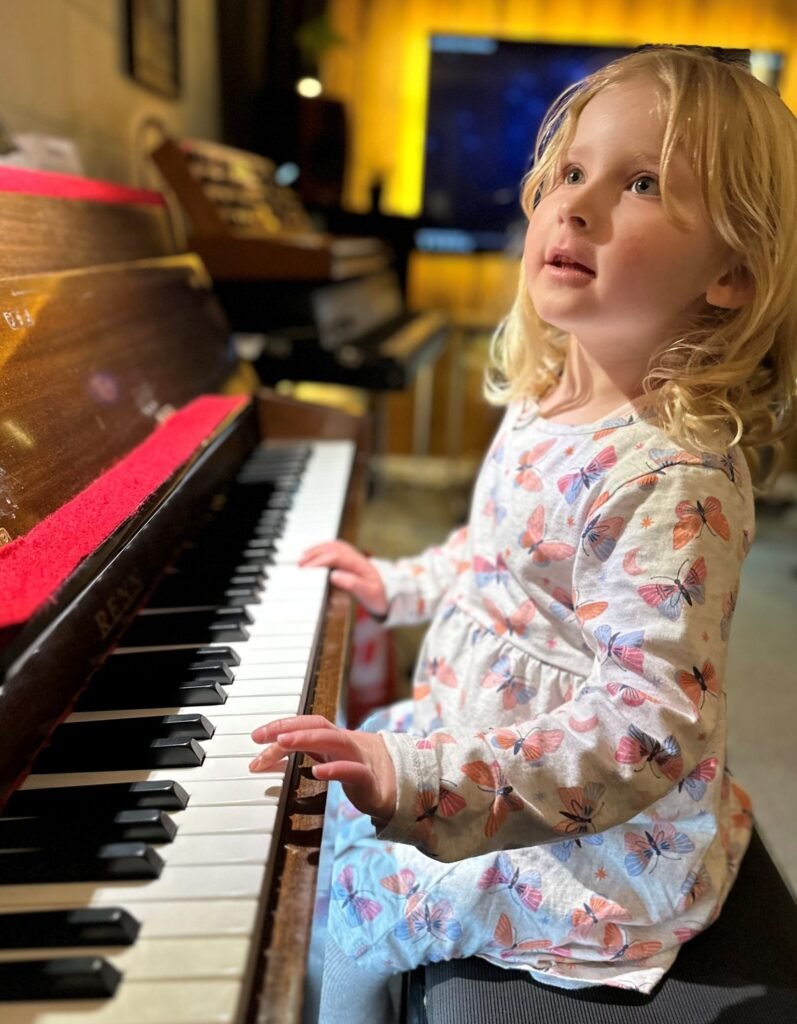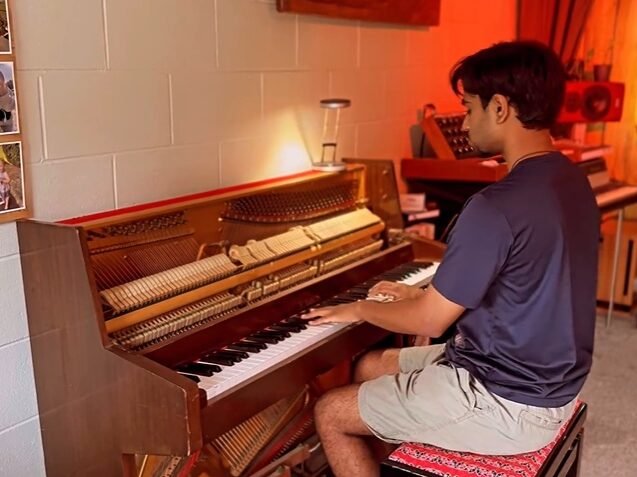Transitioning from classical to jazz piano opens up a world of creative freedom and musical expression. Whether you’re an experienced classical pianist or a beginner looking to explore jazz, this guide will help you navigate the shift in mindset, technique, and approach required to master jazz piano.
Table of Contents
- Understanding the Key Differences Between Classical and Jazz Piano
- Practical Steps to Transition from Classical to Jazz Piano
- The Role of Music Theory in Learning Jazz Piano
- Developing Listening Skills and Drawing Inspiration from Jazz Legends
- Why Choose Timothy William for Jazz Piano Lessons in Auckland
- Frequently Asked Questions About Learning Jazz Piano
Understanding the Key Differences Between Classical and Jazz Piano
Making the transition from classical to jazz piano starts with understanding how the two genres differ fundamentally. While both styles demand technical skill and musical knowledge, their approach to performance, composition, and improvisation varies significantly. Recognising these differences will set the stage for your jazz piano journey.
The Role of Structure and Improvisation
Classical piano is rooted in structured compositions. Performers focus on interpreting pieces as faithfully as possible to the composer’s intentions, relying on detailed sheet music for guidance. Jazz piano, by contrast, thrives on improvisation and spontaneity. In jazz, the performer often uses a lead sheet—a simplified notation of melody and chords—as a foundation to create unique interpretations during every performance.
For classical pianists, this shift can be both liberating and challenging. Instead of meticulously following a written score, jazz pianists must develop the confidence to create in the moment, trusting their ear and instinct. Improvisation becomes a core skill, requiring practice and an understanding of harmony, scales, and rhythmic patterns.
Harmonic Flexibility in Jazz
Another key difference is the use of harmony. Classical music often adheres to strict harmonic progressions, with established rules dictating chord usage. Jazz, however, is far more flexible, encouraging pianists to experiment with chord extensions, substitutions, and alterations. This creates a rich palette of sounds that is unique to the jazz idiom.
For instance, where a classical piece might use a simple C major chord, jazz pianists may opt for a Cmaj7 or even a C13, depending on the mood and context. Mastering these jazz harmonies requires an understanding of music theory and frequent experimentation at the keyboard.
Rhythmic Complexity
Rhythm is another area where jazz piano differs from classical. While classical music may include intricate rhythms, jazz places a heavy emphasis on syncopation, swing, and groove. Swing rhythm, which gives jazz its distinctive “feel,” can be tricky for classically trained musicians to grasp initially. It involves playing eighth notes unevenly, with a longer first note and a shorter second note in each pair, creating a “long-short” rhythmic pattern.
Additionally, jazz pianists often accompany other musicians in a rhythm section, requiring them to lock into the groove established by the bass and drums. This collaborative approach to rhythm is a stark contrast to the solo focus of most classical piano performances.
Performance Mindset and Interpretation
Classical pianists are typically taught to prioritise precision and accuracy, aiming to deliver performances that are true to the original score. In jazz, the focus shifts to personal interpretation and expression. While there are “standards” in jazz—a repertoire of popular songs that every jazz musician knows—each performance of a standard is expected to be unique.
Developing this mindset requires a willingness to take risks and embrace mistakes as part of the learning process. Jazz piano celebrates individuality and creative flair, allowing pianists to develop their own voice and style.
The Learning Curve
For classical pianists, the transition to jazz can feel like learning a new language. However, many of the skills developed through classical training—such as technical proficiency, an understanding of music theory, and strong sight-reading abilities—provide a solid foundation for jazz. The key is to approach jazz with an open mind and a willingness to step outside the comfort zone of classical tradition.
In the next section, we’ll explore practical steps for making the transition from classical to jazz piano, including specific exercises and techniques to get started.
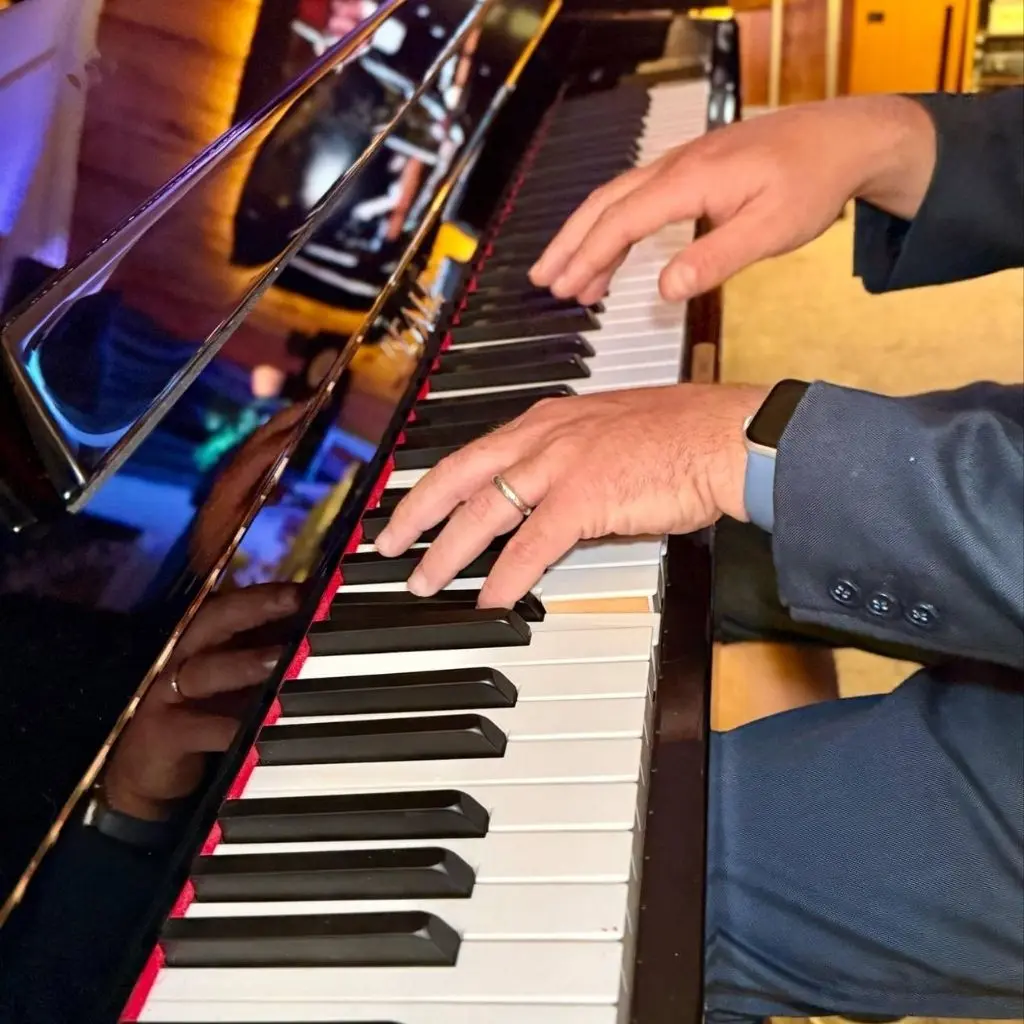
Practical Steps to Transition from Classical to Jazz Piano
Transitioning from classical to jazz piano requires a deliberate shift in approach, coupled with dedicated practice. In this section, we’ll delve into practical exercises and strategies that can help classical pianists begin their jazz journey. By focusing on key skills such as improvisation, chord voicings, and swing rhythm, you can build the foundation for becoming a confident jazz pianist.
Start with Jazz Standards
The best way to dive into jazz piano is by learning jazz standards—popular songs that form the core repertoire of the genre. Standards such as “Autumn Leaves”, “All of Me”, and “Fly Me to the Moon” are excellent starting points because they feature simple chord progressions and memorable melodies. These songs introduce you to the harmonic and melodic language of jazz while providing a framework for improvisation.
Begin by learning the melody and chord changes for each standard. Focus on playing them accurately and rhythmically, ensuring you understand the harmonic structure. Once you’re comfortable, try experimenting with the chords by adding extensions (e.g., 7ths, 9ths, and 13ths) and substituting alternate voicings. This process will help you break free from the rigidity of classical scores and develop a more creative approach to piano playing.
Practice Improvisation Exercises
Improvisation is at the heart of jazz, but it can be intimidating for classical pianists who are used to following a written score. To ease into improvisation, start with simple exercises such as:
- Scales and Modes: Choose a key and practise improvising melodies using the corresponding major scale or mode (e.g., Dorian, Mixolydian). Experiment with different note rhythms and combinations.
- Chord Tones: Focus on improvising melodies using the chord tones (root, 3rd, 5th, and 7th) of each chord in a progression. This helps you outline the harmony and create coherent solos.
- Call and Response: Play a short melodic phrase (the “call”) and then respond with another phrase that complements it. This exercise mimics the conversational aspect of jazz improvisation.
As you become more comfortable, try improvising over the chord changes of jazz standards. Start with simple two-chord progressions and gradually work up to more complex tunes.
Master Jazz Chord Voicings
Jazz chords differ significantly from the triads and basic seventh chords commonly used in classical music. To play jazz piano effectively, you’ll need to learn how to build and play advanced chord voicings. Key concepts to explore include:
- Shell Voicings: These are simple two- or three-note voicings that include the root, 3rd, and 7th of a chord. Shell voicings are ideal for beginners because they are easy to play and provide a clear harmonic foundation.
- Rootless Voicings: In jazz, the bass player typically handles the root of each chord, allowing pianists to focus on the upper chord tones (e.g., 3rd, 7th, 9th, and 13th). Rootless voicings create a fuller, more colourful sound.
- Drop 2 Voicings: This technique involves “dropping” the second-highest note of a chord an octave lower, creating a more spread-out texture. Drop 2 voicings are commonly used in jazz piano accompaniment.
To practise chord voicings, start with basic ii-V-I progressions (e.g., Dm7-G7-Cmaj7 in C major) and experiment with different ways to voice each chord. Over time, you’ll develop a repertoire of voicings that you can apply to any jazz standard.
Develop a Sense of Swing
Swing is an essential element of jazz that gives the music its characteristic “feel.” To develop a sense of swing, listen to recordings of jazz pianists such as Bill Evans, Oscar Peterson, and Herbie Hancock. Pay attention to how they phrase melodies and rhythms, and try to emulate their style.
One effective exercise for practising swing is to play scales or simple melodies using a swing rhythm. For example, instead of playing straight eighth notes, play them with a “long-short” feel, emphasising the off-beats. Additionally, practise comping (accompanying) with your left hand while keeping a steady swing rhythm in your right hand. This will improve your coordination and ability to maintain a groove.
Learn to Read Lead Sheets
In jazz, pianists often work from lead sheets rather than fully notated scores. A lead sheet provides the melody and chord symbols for a song, leaving the performer free to interpret the harmony and arrangement. Learning to read lead sheets is a crucial skill for any jazz pianist.
Start by familiarising yourself with chord symbols and their corresponding voicings. For example, “Cm7” indicates a C minor seventh chord, while “G13” indicates a G dominant thirteenth chord. Practise interpreting lead sheets by playing the melody with your right hand and accompanying with chords in your left hand. Over time, you can experiment with embellishing the melody, reharmonising the chords, and adding improvisation.
Jam with Other Musicians
Jazz is a social genre that thrives on collaboration. To develop your skills, seek out opportunities to play with other musicians. Jamming with a rhythm section (bass and drums) is particularly valuable because it forces you to listen, adapt, and interact in real time.
If you’re based in Auckland, you may find local jam sessions or open mic nights where you can connect with other jazz enthusiasts. Playing with others will accelerate your learning and expose you to new ideas and styles.
In the next section, we’ll explore how to integrate music theory into your jazz piano practice, ensuring you have a solid foundation for improvisation and harmony.

The Role of Music Theory in Learning Jazz Piano
Music theory is the cornerstone of mastering jazz piano, offering a deep understanding of harmony, melody, and rhythm. For classical pianists transitioning to jazz, music theory bridges the gap between the structured world of classical compositions and the freedom of jazz improvisation. In this section, we’ll explore how to apply music theory to jazz piano, covering essential topics such as scales, chord construction, and harmonic analysis.
Understanding Jazz Scales and Modes
Scales and modes are fundamental tools for jazz improvisation and composition. While classical pianists are often familiar with major and minor scales, jazz expands this palette to include modes and other unique scales that add colour and variety to solos.
Key scales to master include:
- Major and Minor Scales: These are the foundation of all Western music and are essential for improvisation. In jazz, minor scales are often used in modal improvisation (e.g., the Dorian mode).
- The Modes of the Major Scale: These include Dorian, Phrygian, Lydian, Mixolydian, Aeolian, and Locrian. Each mode has a unique character and is suited to specific types of chords. For example, the Mixolydian mode is commonly used over dominant 7th chords.
- The Blues Scale: This scale, characterised by its flattened 3rd, 5th, and 7th degrees, is essential for playing blues and jazz. It provides a soulful, expressive sound that defines many jazz solos.
- The Pentatonic Scale: A five-note scale that is versatile and widely used in both jazz and blues. It’s a great starting point for beginners learning to improvise.
To integrate scales into your practice, focus on playing them over common chord progressions, such as ii-V-I, in all keys. Experiment with different rhythmic patterns and phrasing to create dynamic, interesting solos.
Mastering Jazz Chord Construction
Jazz chords are more complex than the triads and basic seventh chords found in classical music. Understanding how to construct and use these chords is a critical step in transitioning to jazz piano.
Here are the key concepts to focus on:
- Extensions: Jazz chords often include notes beyond the 7th, such as the 9th, 11th, and 13th. For example, a C13 chord includes the notes C, E, G, Bb, D, A.
- Alterations: Altered chords include notes that are sharpened or flattened, such as a #9 or b13. These chords add tension and resolve beautifully within jazz progressions.
- Chord Substitutions: In jazz, it’s common to replace one chord with another that has a similar harmonic function. For example, a dominant chord can be replaced with a tritone substitution. This technique adds variety and sophistication to your playing.
Practise constructing these chords in all keys, using both hands to experiment with different voicings. Over time, you’ll develop an instinct for choosing the right chords in any musical context.
Harmonic Analysis of Jazz Progressions
Harmonic analysis is the process of understanding the structure of a piece by examining its chord progressions. For classical pianists, this skill can be a valuable tool for learning jazz standards and improvising effectively.
Start by analysing the most common jazz chord progression: the ii-V-I. This progression appears in countless jazz standards and serves as the foundation for many improvisations. For example, in the key of C major, the ii-V-I progression would be Dm7 – G7 – Cmaj7.
As you progress, study more complex progressions, such as turnaround sequences and modal interchange. Understanding these harmonic concepts will deepen your appreciation of jazz music and improve your ability to navigate chord changes in real time.
Applying Music Theory to Improvisation
Improvisation is where music theory truly comes to life in jazz. By applying theoretical concepts to your solos, you can create coherent, expressive performances. Here are some practical tips for integrating theory into improvisation:
- Target Chord Tones: When improvising, focus on emphasising the 3rd and 7th of each chord, as these notes define its character. For example, over a G7 chord, you might target the notes B (3rd) and F (7th).
- Use Passing Tones and Enclosures: Add interest to your solos by including non-chord tones that resolve to chord tones. For example, you might play a sequence of notes that surrounds the target tone before landing on it.
- Experiment with Modes: Choose a mode that matches the underlying chord and use it to construct melodies. For instance, the Lydian mode is often used over major chords for a bright, modern sound.
Practise improvising over jazz standards, starting with simple chord progressions and gradually incorporating more complex ideas. Record your sessions to evaluate your progress and identify areas for improvement.
Integrating Theory into Your Practice Routine
To maximise the benefits of music theory, make it a core part of your daily practice. Here’s a suggested routine:
- Warm up with scales and arpeggios, focusing on different keys and modes.
- Practise constructing and playing jazz chords, using a variety of voicings.
- Analyse the chord progressions of a jazz standard and experiment with improvising over them.
- Review theoretical concepts regularly, using textbooks or online resources for guidance.
By combining theory with practical application, you’ll gain a deeper understanding of jazz and become a more versatile pianist.
In the next section, we’ll discuss how to develop your listening skills and draw inspiration from iconic jazz pianists to refine your playing style.
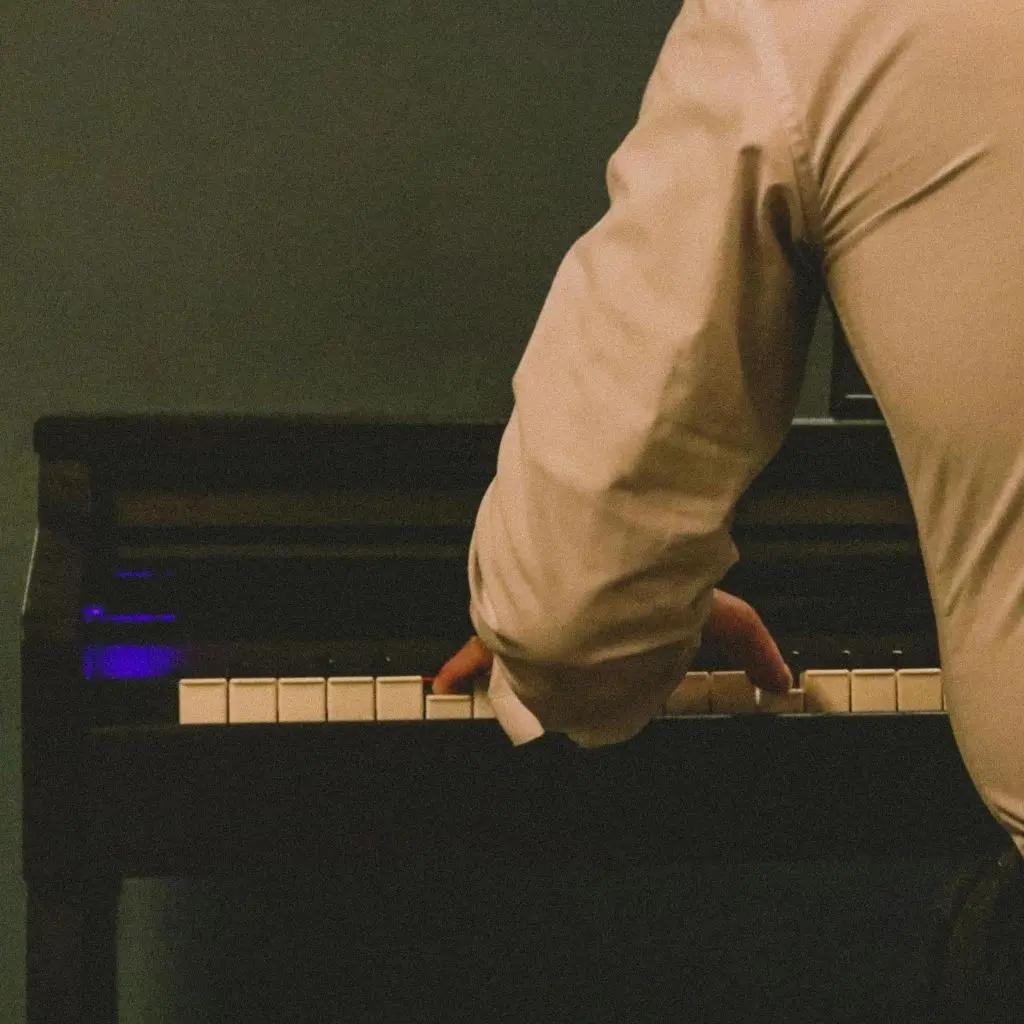
Developing Listening Skills and Drawing Inspiration from Jazz Legends
Jazz is as much about listening as it is about playing. For classical pianists transitioning to jazz, developing active listening skills and studying the works of iconic jazz pianists can provide invaluable insights into the genre’s nuances, styles, and techniques. In this section, we’ll explore how to train your ear, analyse recordings, and draw inspiration from jazz legends to refine your own playing style.
The Importance of Active Listening in Jazz
Active listening is a critical skill for jazz musicians. Unlike classical music, where performers typically interpret a pre-written score, jazz requires musicians to interact dynamically with the music and their fellow players. Listening helps you internalise the rhythms, harmonies, and phrasing that define the jazz style.
Here’s how to practise active listening effectively:
- Focus on One Element at a Time: When listening to a jazz recording, isolate specific elements such as the piano accompaniment, the melody, or the rhythm section. Pay attention to how each part contributes to the overall sound.
- Transcribe Solos: Choose a solo by a jazz pianist you admire and transcribe it note-for-note. This exercise helps you understand their phrasing, note choices, and rhythmic approach.
- Analyse Chord Voicings: Listen carefully to how pianists voice chords. Try to identify the specific notes they use and replicate these voicings on your own instrument.
- Practice Call and Response: Play back short phrases you hear on a recording, mimicking the rhythm, articulation, and dynamics. This helps you internalise the language of jazz.
Over time, active listening will sharpen your ear and enhance your ability to improvise, comp, and interact with other musicians.
Studying the Greats: Iconic Jazz Pianists to Inspire You
Learning from the masters is one of the best ways to develop your jazz piano skills. Each iconic pianist has a unique style that offers valuable lessons for aspiring musicians. Here are some jazz legends to explore:
- Bill Evans: Known for his lyrical playing and sophisticated harmonies, Bill Evans revolutionised jazz piano with his innovative use of chord voicings and modal improvisation. Listen to albums like “Portrait in Jazz” and “Waltz for Debby” for inspiration.
- Oscar Peterson: Renowned for his technical brilliance and swing feel, Oscar Peterson’s energetic performances showcase the power of rhythmic precision and bluesy phrasing. Start with albums like “Night Train” and “The Trio”.
- Herbie Hancock: A master of blending jazz with funk, rock, and electronic music, Herbie Hancock’s versatility and creativity make him a key figure in jazz history. Albums like “Maiden Voyage” and “Head Hunters” highlight his innovative approach.
- Thelonious Monk: With his angular melodies and unconventional rhythms, Thelonious Monk’s music offers a fresh perspective on jazz composition and improvisation. Explore albums like “Brilliant Corners” and “Monk’s Dream”.
- Chick Corea: A pioneer of jazz fusion, Chick Corea’s work spans a wide range of styles, from bebop to Latin jazz. Albums like “Return to Forever” and “Now He Sings, Now He Sobs” are essential listening.
As you study these pianists, pay attention to their phrasing, use of dynamics, and interaction with other musicians. Try incorporating elements of their playing into your own style.
Building Your Jazz Vocabulary
Jazz, like any language, has its own vocabulary. By learning common licks, patterns, and phrases used by great pianists, you can expand your improvisational toolkit. Start by transcribing short phrases from recordings and practising them in all keys. Over time, you’ll build a repertoire of ideas that you can draw upon during solos.
In addition to transcribing, consider studying jazz method books and instructional videos. Resources such as “The Jazz Piano Book” by Mark Levine or online tutorials from experienced musicians can provide valuable guidance.
Learning to Play by Ear
Playing by ear is an essential skill for jazz pianists. Unlike classical music, where sight-reading is a primary focus, jazz often relies on the ability to hear and reproduce melodies, harmonies, and rhythms. Here are some tips for developing your ear:
- Start with Simple Melodies: Choose a simple jazz standard and try to play the melody by ear. Focus on identifying intervals and matching the pitch on your instrument.
- Recognise Chord Progressions: Train your ear to identify common progressions, such as ii-V-I or the 12-bar blues. Practice by listening to recordings and playing along with the chords.
- Sing Along: Singing melodies, bass lines, or even improvised solos can help you internalise the music and improve your ability to play by ear.
Consistent practice will strengthen your ear and make it easier to learn and perform jazz pieces without relying solely on sheet music.
Finding Inspiration in Local Jazz Scenes
For pianists in Auckland, New Zealand, the local jazz scene offers plenty of opportunities to draw inspiration and connect with other musicians. Attend live performances at venues such as the Auckland Jazz & Blues Club or participate in open jam sessions to immerse yourself in the vibrant jazz community.
Engaging with local musicians can provide valuable insights into the art of jazz performance and introduce you to new styles and techniques. You may also discover potential collaborators who share your passion for jazz piano.
In the next section, we’ll discuss why Timothy William’s personalised approach to music education makes him the ideal choice for learning jazz piano in Auckland.
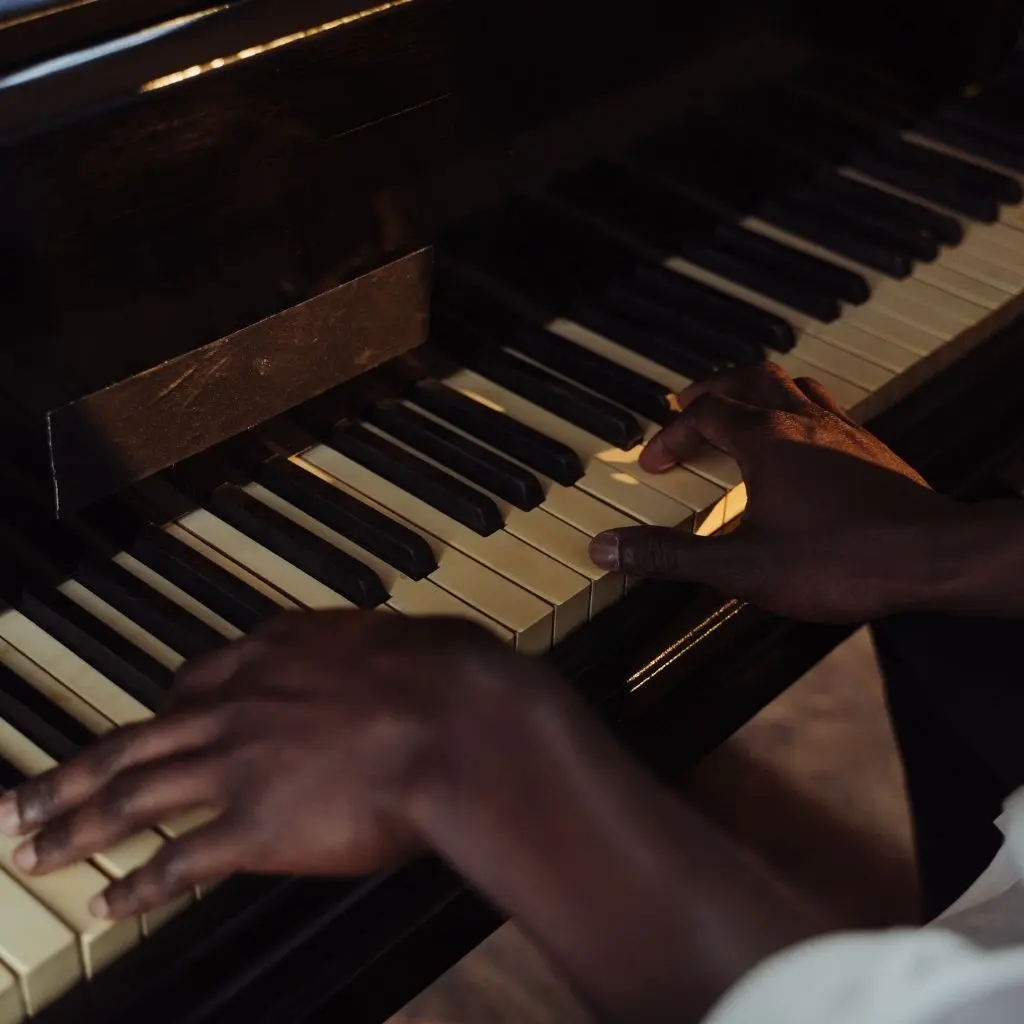
Why Choose Timothy William for Jazz Piano Lessons in Auckland
Learning jazz piano is a rewarding journey, but it can be challenging without the right guidance. This is where Timothy William, a highly experienced music teacher based in Auckland, comes in. With his personalised teaching approach, broad expertise, and passion for music education, Timothy helps students of all ages and skill levels make a smooth transition from classical to jazz piano.
Personalised Lessons Tailored to Your Goals
One of the key reasons to choose Timothy William is his ability to customise lessons to each student’s unique needs and goals. Whether you’re a classically trained pianist looking to explore jazz for the first time or an intermediate player aiming to deepen your improvisation skills, Timothy adapts his teaching methods to suit your learning pace and musical preferences.
His personalised approach ensures that every lesson is engaging, effective, and aligned with your musical aspirations. By focusing on your strengths and addressing areas for improvement, Timothy helps you build confidence and achieve tangible progress.
Extensive Experience in Both Classical and Jazz Piano
Timothy William brings years of experience as a music educator and performer in both classical and jazz genres. This dual expertise makes him uniquely qualified to guide students transitioning from classical to jazz piano. He understands the challenges that classically trained musicians face when learning jazz and offers practical strategies to overcome them.
Timothy’s lessons go beyond technical skills, providing insights into the stylistic nuances of jazz, from swing rhythm and chord voicings to improvisation and jazz theory. His in-depth knowledge ensures that you gain a comprehensive understanding of the genre, enabling you to play with confidence and authenticity.
A Supportive and Encouraging Learning Environment
Timothy creates a supportive and encouraging atmosphere where students feel comfortable exploring new concepts and taking creative risks. He believes that mistakes are an essential part of the learning process and encourages students to view them as opportunities for growth.
This positive approach fosters a love for music and empowers students to express themselves freely through their playing. Whether you’re nervous about improvisation or struggling with complex jazz chords, Timothy’s patient guidance helps you overcome challenges and enjoy the learning experience.
Flexible Lesson Options in Auckland
Based in Auckland, Timothy offers flexible lesson options to accommodate the busy schedules of his students. Lessons are available for individuals of all ages, from young beginners to adults returning to piano after a break. Whether you prefer in-person sessions or the convenience of online lessons, Timothy ensures a seamless learning experience tailored to your needs.
Additionally, his familiarity with the local music scene in Auckland provides opportunities for students to participate in performances, jam sessions, and other musical events. These experiences enhance your learning and give you the chance to apply your skills in real-world settings.
Get Started on Your Jazz Piano Journey Today
Transitioning from classical to jazz piano is an exciting challenge that opens the door to endless musical possibilities. With Timothy William as your teacher, you’ll receive expert guidance, personalised support, and a solid foundation in jazz piano techniques.
Don’t wait to start your jazz piano journey. Contact Timothy William today to book your first lesson and discover how his expertise can help you achieve your musical goals.
Contact Timothy William
- Phone: +6421539273
- Email: tim@timothywilliam.co.nz
- Location: Auckland, New Zealand
Take the first step towards mastering jazz piano with Timothy William, Auckland’s trusted music teacher. Whether you’re a beginner or an experienced classical pianist, Timothy’s lessons will inspire and empower you to embrace the joy of jazz.
In the next section, we’ll address common questions about transitioning to jazz piano, providing detailed answers to help you feel more confident about starting your jazz journey.


